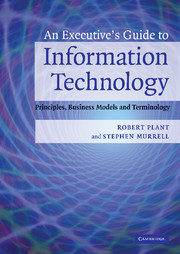Book contents
- Frontmatter
- Contents
- Introduction
- A ACM (Association for Computing Machinery) to Audio
- B Backup to Business process re-engineering
- C C, C++, C# to Cracking
- D Database to Dynamic web pages
- E e-Commerce/e-business to European Union Directive on Privacy and Electronic Commerce 2002
- F Fiber optics to Fuzzy logic
- G to H Global positioning system to Hypertext, HTML
- I ICANN (Internet Corporation for Assigned Names and Numbers) to ISP (Internet service provider)
- J to L Java to Logic programming
- M Machine learning to Multicast
- N Natural language processing (NLP) to Normalization
- O Object-oriented to Outsourcing
- P Packet switching and circuit switching to Public key-private key
- Q to R Quantum computing to RSS (Really simple syndication)
- S Sarbanes-Oxley Act of 2002 (SOX) to Structured design methodologies
- T to U T-Carrier to URL (Uniform resource locator)
- V Value added network (VAN) to Voice over IP (VoIP)
- W W3C (the World Wide Web Consortium) to WYSIWYG
- X to Z X.12 to Zip
- Index
- References
W - W3C (the World Wide Web Consortium) to WYSIWYG
Published online by Cambridge University Press: 17 May 2010
- Frontmatter
- Contents
- Introduction
- A ACM (Association for Computing Machinery) to Audio
- B Backup to Business process re-engineering
- C C, C++, C# to Cracking
- D Database to Dynamic web pages
- E e-Commerce/e-business to European Union Directive on Privacy and Electronic Commerce 2002
- F Fiber optics to Fuzzy logic
- G to H Global positioning system to Hypertext, HTML
- I ICANN (Internet Corporation for Assigned Names and Numbers) to ISP (Internet service provider)
- J to L Java to Logic programming
- M Machine learning to Multicast
- N Natural language processing (NLP) to Normalization
- O Object-oriented to Outsourcing
- P Packet switching and circuit switching to Public key-private key
- Q to R Quantum computing to RSS (Really simple syndication)
- S Sarbanes-Oxley Act of 2002 (SOX) to Structured design methodologies
- T to U T-Carrier to URL (Uniform resource locator)
- V Value added network (VAN) to Voice over IP (VoIP)
- W W3C (the World Wide Web Consortium) to WYSIWYG
- X to Z X.12 to Zip
- Index
- References
Summary
Foundation concepts: Internet, World Wide Web.
Definition: In their own words, “The World Wide Web Consortium (W3C) is an international consortium where member organizations, a full-time staff, and the public work together to develop web standards” (http://www.w3.org/Consortium/).
Overview
The W3C was founded in 1994 by Tim Berners-Lee, the inventor of the World Wide Web, and MIT in collaboration with CERN, DARPA, and the European Commission. The organization aims to develop inter-operable technologies and provide specifications, guidelines, software, and tools to help the web to reach its full potential. A primary aim of the consortium is to develop non-proprietary standards and promote inter-operability. The consortium is international in scope, has offices in fourteen locations around the world, and draws its membership from around the globe (http://www.w3.org/).
The W3C is behind many of the technologies that are in common global use, such as HTML, SOAP/XMLP, URLs, and XML.
Business value proposition
The W3C is an organization that provides leadership in the area of web technologies. Individuals and corporations can become members and, through working committees, help to develop the formulations of future web-based technologies.
Summary of positive issues
W3C provides a forum through which web-based technologies are developed. Organizations are able to join the consortium and work with the committees to innovate and create new technologies.
- Type
- Chapter
- Information
- An Executive's Guide to Information TechnologyPrinciples, Business Models, and Terminology, pp. 346 - 357Publisher: Cambridge University PressPrint publication year: 2007



